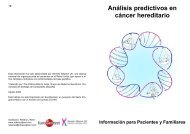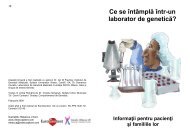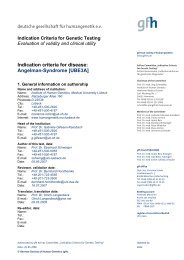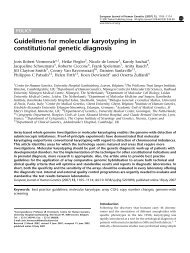Cytogenetic Guidelines and Quality Assurance - EuroGentest
Cytogenetic Guidelines and Quality Assurance - EuroGentest
Cytogenetic Guidelines and Quality Assurance - EuroGentest
You also want an ePaper? Increase the reach of your titles
YUMPU automatically turns print PDFs into web optimized ePapers that Google loves.
used) controls. It is recommended that centrally<br />
monitored alarm systems are available.<br />
18<br />
Laboratories performing prenatal analyses should<br />
possess at least two incubators for splitting of prenatal<br />
specimens. It is also recommended that prenatal <strong>and</strong><br />
non-prenatal cultures are incubated separately to<br />
minimise the risk of microbial cross-contamination.<br />
4.2.3 IMAGE CAPTURE SYSTEMS<br />
To maintain a high quality service provision all image<br />
analysis systems should be maintained regularly with<br />
software upgrades.<br />
The number of image processing systems should not<br />
be a limiting factor in specimen analysis. When using<br />
image analysis systems, one part of the analysis process,<br />
either the initial analysis or the checking, should<br />
be completed using a microscope to ensure small<br />
markers or additional chromosomes have not been<br />
overlooked.<br />
To avoid unnecessary delays due to image systems<br />
faults/failure, a service agreement is highly recommended.<br />
4.3 TECHNICAL ASPECTS<br />
OF CYTOGENETICS<br />
4.3.1 CELL CULTURES<br />
Duplicated or independently established cultures,<br />
where possible, are recommended for all types of cultured<br />
specimens.<br />
4.3.2 BANDING<br />
All karyotyping should be carried out using a b<strong>and</strong>ing<br />
technique. In no cases, except some chromosome<br />
breakage syndromes, should a report be issued without<br />
cells having been subjected to full analysis of the<br />
b<strong>and</strong>ing pattern for the whole chromosome complement.<br />
The ISCN defines five levels of b<strong>and</strong>ing. This can be<br />
used as a guide for establishing the degree of resolution<br />
required in producing a result. Several useful<br />
methods have been developed to help assess b<strong>and</strong>ing<br />
quality. Some countries e.g. Germany <strong>and</strong> the UK use<br />
an alternative approach that designates a quality score<br />
representing which chromosome b<strong>and</strong>s are visible at<br />
250 (QAS 2), 350 (QAS 4) <strong>and</strong> 550 (QAS 6) bphs<br />
resolution. More information can be found on the<br />
ACC (www.cytogenetics.org.uk under info) <strong>and</strong><br />
BVDH (www.gfhev.de/en/membership/ under quality<br />
management) websites.<br />
Numerical <strong>and</strong> structural abnormalities have to be excluded<br />
at a b<strong>and</strong>ing level appropriate to the referral<br />
reason. One or more objective <strong>and</strong> reproducible method(s)<br />
must be used to assess b<strong>and</strong>ing resolution <strong>and</strong><br />
must be described in the laboratory protocol book or<br />
User Guide.<br />
A st<strong>and</strong>ardised method for assessing b<strong>and</strong>ing quality<br />
should be used, with an agreed minimum st<strong>and</strong>ard that<br />
may vary depending on the reason for referral. Full<br />
analysis must be completed to the satisfaction of the<br />
supervisor that numerical <strong>and</strong> structural abnormalities<br />
have been excluded to a level appropriate for the referral<br />
reason. Specific st<strong>and</strong>ards for resolution should<br />
be appropriate to the case <strong>and</strong> the type of tissue<br />
studied. The 400 bphs (QAS 4) level is the minimum















